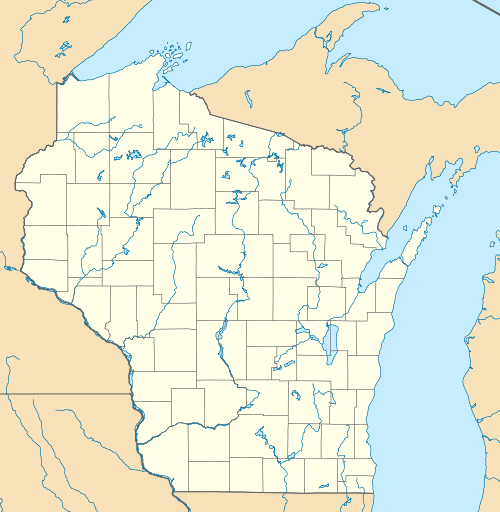Point Beach Nuclear Plant
| Point Beach Nuclear Plant | |
|---|---|
.jpg) Point Beach Nuclear Plant | |
 Location of Point Beach Nuclear Plant in Wisconsin | |
| Country | United States |
| Location | Town of Two Creeks, Manitowoc County, near Two Rivers, Wisconsin |
| Coordinates | 44°16′52″N 87°32′12″W / 44.28111°N 87.53667°WCoordinates: 44°16′52″N 87°32′12″W / 44.28111°N 87.53667°W |
| Status | Operational |
| Commission date |
Unit 1: December 21, 1970 Unit 2: October 1, 1972 |
| Construction cost | US$589.1M (2007 prices) |
| Owner(s) | NextEra Energy Resources |
| Nuclear power station | |
| Reactor type | PWR |
| Reactor supplier | Westinghouse |
| Power generation | |
| Units operational | Unit 1: 620 MW, Unit 2: 620 MW |
| Nameplate capacity | 1,026 MW |
| Capacity factor | 86.4% |
| Average generation | 7,767 GWh |
|
Website fact sheet | |
Point Beach Nuclear Plant is a nuclear power plant located on Lake Michigan north of Two Rivers, Wisconsin, USA.
The plant is currently owned and operated by NextEra Energy Resources (prior to 2009 - FPL Energy), of Juno Beach, Florida. The plant was built by Wisconsin Electric Power Company (now We Energies, a subsidiary of Wisconsin Energy Corporation), and previously operated by the Nuclear Management Company.
NextEra Energy Resources purchased the plant from Wisconsin Electric Power Company in October 2007.[1] As part of the sale, We Energies agreed to repurchase all of the power produced by the plant for at least 20 years. In 2000–2007 the plant was managed by the Nuclear Management Company.
This plant has two Westinghouse pressurized water reactors. There is also a visitors' center located at the Point Beach plant.
In 2005, the U.S. Nuclear Regulatory Commission (NRC) approved the license renewal application for the Point Beach plant, extending the operating license from forty years to sixty.
Most of the power from this plant goes to the Green Bay area and communities along the Lake Michigan shoreline of Southeastern Wisconsin. The plant is connected to the grid by four 345 kV lines, one of which travels northwest towards Green Bay and then on to the We Energies North Appleton substation located about 12 miles north of Appleton, Wisconsin, and the other one interconnecting with the now-closed[2] Kewaunee Nuclear Generating Station located a short distance away to the north from Point Beach. The other 345 kV lines going out of the plant go south towards Milwaukee. Several 138 kV lines going out of the plant supply electricity to the surrounding area.
Surrounding population
The Nuclear Regulatory Commission defines two emergency planning zones around nuclear power plants: a plume exposure pathway zone with a radius of 10 miles (16 km), concerned primarily with exposure to, and inhalation of, airborne radioactive contamination, and an ingestion pathway zone of about 50 miles (80 km), concerned primarily with ingestion of food and liquid contaminated by radioactivity.[3]
The 2010 U.S. population within 10 miles (16 km) of Point Beach was 19,975, a decrease of 6.7 percent in a decade, according to an analysis of U.S. Census data for msnbc.com. The 2010 U.S. population within 50 miles (80 km) was 777,556, an increase of 10.0 percent since 2000. Cities within 50 miles include Green Bay (28 miles to city center).[4]
Seismic risk
The Nuclear Regulatory Commission's estimate of the risk each year of an earthquake intense enough to cause core damage to the reactor at Point Beach was 1 in 90,909, according to an NRC study published in August 2010. This was tied for 62 in a list of 104 with #1 being most at risk.[5][6]
References
- ↑ "Wisconsin Energy Transfers Ownership of Point Beach Nuclear Plant to FPL Energy". 2007-10-01.
- ↑ Matthew L. Wald (May 7, 2013). "As Price of Nuclear Energy Drops, a Wisconsin Plant Is Shut". The New York Times. Retrieved May 8, 2013.
- ↑ "Backgrounder on Emergency Preparedness at Nuclear Power Plants". NRC.gov. Archived from the original on 2006-10-02.
- ↑ Dedman, Bill (April 14, 2011). "Nuclear neighbors: Population rises near US reactors". msnbc.com. Retrieved May 1, 2011.
- ↑ Dedman, Bill (March 17, 2011). "What are the odds? US nuke plants ranked by quake risk". msnbc.com. Retrieved April 19, 2011.
- ↑ Hiland, Patrick (September 2, 2010). "Safety / Risk Assessment Results for Generic Issue 199" (PDF). msnbc.com. Office of Nuclear Regulatory Research.
External links
- NukeWorker
- "Wisconsin Nuclear Plants#Point Beach". Energy Information Administration, U.S. Department of Energy (DOE). September 1, 2010. Retrieved 2011-03-16.
- "Point Beach 1 Pressurized Water Reactor". Operating Nuclear Power Reactors. U.S. Nuclear Regulatory Commission (NRC). February 14, 2008. Retrieved 2008-11-21.
- "Point Beach 2 Pressurized Water Reactor". Operating Nuclear Power Reactors. NRC. February 14, 2008. Retrieved 2008-11-21.